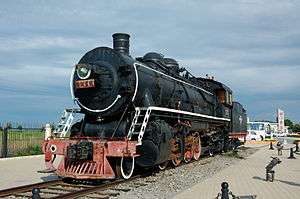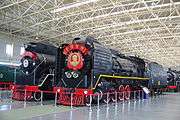China Railways JF
解放
JF
 |
|
|
| Specifications |
|---|
| Gauge |
1,435 mm (4 ft 8 1⁄2 in) |
|---|
| Driver dia. |
1,370 mm (53.94 in) |
|---|
| Minimum curve |
145 m (476 ft) |
|---|
| Wheelbase |
4.419 m (14 ft 5.98 in) (fixed)
10.192 m (33 ft 5.3 in) (loco total)
19.780 m (64 ft 10.7 in) (loco & tender) |
|---|
| Length |
22.634 m (74 ft 3.1 in)[2] / 23.750 m (77 ft 11.0 in)[3] |
|---|
| Width |
3.080 m (10 ft 1.26 in) |
|---|
| Height |
4.780 m (15 ft 8.19 in) |
|---|
| Adhesive weight |
79.94 t (78.68 long tons; 88.12 short tons)
(adhesive weight) |
|---|
| Loco weight |
103.85 t (102.21 long tons; 114.48 short tons),
94.10 t (92.61 long tons; 103.73 short tons) (empty) |
|---|
| Tender cap |
14 t (13.8 long tons; 15.4 short tons) (coal),
30 m3 (1,059 cu ft) (water) |
|---|
Firebox:
• Firegrate area |
5.09 m2 (54.8 sq ft) |
|---|
| Boiler pressure |
14 atm (1,400 kPa; 210 psi) |
|---|
| Cylinders |
2 |
|---|
| Cylinder size |
580 mm × 710 mm (22.835 in × 27.953 in)
bore x stroke |
|---|
|
| Performance figures |
|---|
| Maximum speed |
80 km/h (50 mph) |
|---|
| Power output |
1,545 hp (1,152 kW) (at wheels) |
|---|
| Tractive effort |
240.3 kN (54,000 lbf) |
|---|
|
|
|
|
Sources:[2][3] except where noted |
The China railways 'Liberation' (解放) type steam locomotive (transliteration Jie Fang: JF) was a type of 2-8-2 mainline general purpose steam locomotive.
The first locomotives of the type were originally used by Imperial Japan on the Asia mainland; the first 20 units were built by ALCO (USA) in 1918, later nearly 2000 machines were built in Japan and at the Shahekou factory (Dalian, northern China) for use in Japanese-occupied northeast China and Korea. After the formation of the People's Republic of China (PRC) over 400 locomotives were manufactured in China for domestic use, manufactured ended in 1960, some locomotive remained in service until the end of the 20th century.
History
The class were introduced to northeast China by the Japanese during their period of influence over the region,[1] (see Russo-Japanese War); the first locomotives were built by the American Locomotive Company (ALCO) in 1918, then at factories in Japan (Hitachi, Kawasaki) and at the Shahekou factory.[3] Under Japanese ownership the locomotives were classed as ㄇㄎ type.[2]
Approximately 140 units were built by 1935, at which time the design underwent modifications, including a shortened boiler and reduced heating surface.[note 1] By the end of the Second Sino-Japanese War (WW2) nearly 2000 units had been built, of which around 1400 were inherited by the PRC.[1]

Celebration of production of JF 2012 at Sifang
From 1950 to 1952 Sifang locomotive works assembled 20 locomotives of the class - locomotive number 2101 was the first produced, and was propagandised as the first Chinese locomotive by the new Chinese state of the People's Republic of China.[4] Sifang, Dalian works, and Qiqihar works were manufacturers of the class. The name 解放 (Liberation), or JF, was adopted in 1959.[2]
The chassis design was combined with a new boiler influenced from Russian designs to create the China Railways JS class, produced from 1957 onwards.[1][5] Production of the JF type ended in 1960 after 455 units had been made.[2]
The locomotives were used across the Chinese railway system, and were in service on the national railway system until 1996; on industrial rail networks some locomotives remained in use until the early 2000s. Several of the class have been preserved.[1]
| JF locomotives at the China Railway Museum |
|---|
| JF-2101, KD5 class in background |
|
Notes
- ↑ The post 1935 design is sometimes designated JF1, to disambiguate.[1]
References
- 1 2 3 4 5 6 Duncan Cotterill, "JF Class 2-8-2", www.railography.co.uk
- 1 2 3 4 5 解放型蒸汽机车, www.zztl.com (in Chinese), archived from the original on 25 December 2008
- 1 2 3 "JF1(ミカイ)形蒸気機関車", www.kuroganerail.jp (in Japanese)
- ↑ 新闻资料:解放型蒸汽机车, news.workercn.cn (in Chinese), pp. 1–3, 14 September 2009 , republished article “国庆号” originally in 人民铁道
- ↑ Duncan Cotterill, "JS Class 2-8-2", Railography
Locomotives of China |
|---|
|
| Steam | |
|---|
|
| Diesel | Diesel hydraulic | |
|---|
| Diesel electric | |
|---|
|
|---|
|
| Electric | |
|---|
|
|



